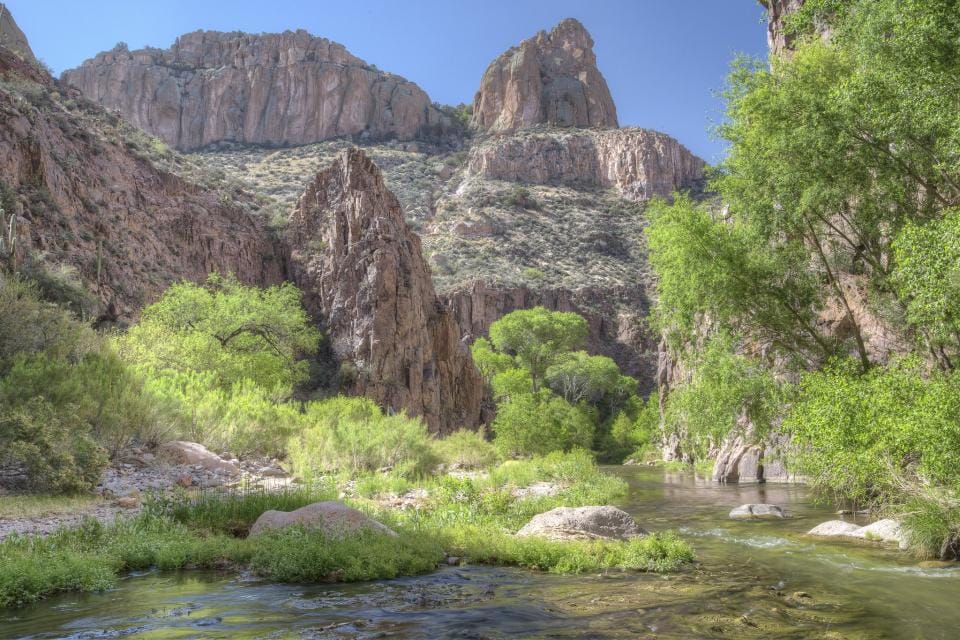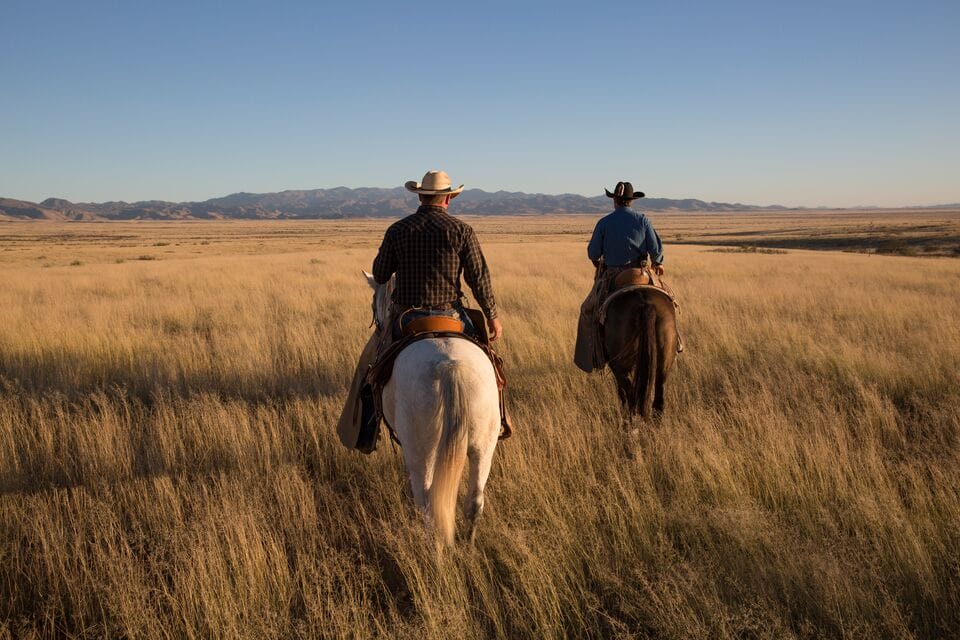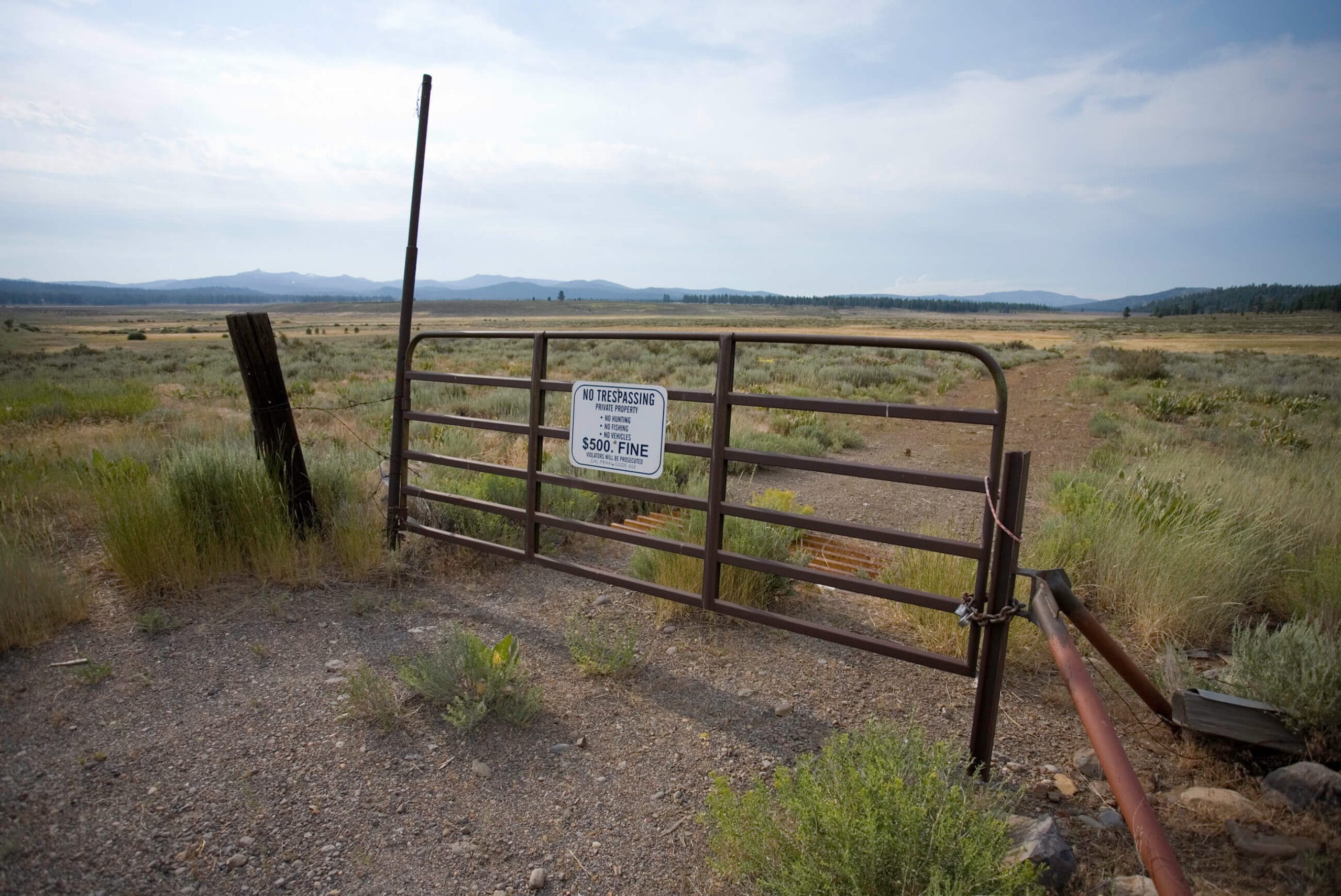Each winter, Janet Drake ventures out from her home in Phoenix to hunt in the Sky Islands. This remote region of southern Arizona is named for the isolated mountain ranges that punctuate expanses of grasslands and canyons.
“There’s a huge range of animals in that area—bear, bobcat, mountain lion, deer, and bighorn sheep,” says Drake.
But a decade ago, one of her favorite areas to hunt was suddenly closed to the public after a new ranch owner decided to lock his gates. The move prevented people like Drake from crossing the ranch owner’s property to access a large public wilderness beyond. Access to that expanse is now restored.
In early November, we announced with the Bureau of Land Management (BLM) the protection of the Cross F Ranch, a rugged landscape connecting Aravaipa Creek and BLM’s Aravaipa Canyon Wilderness to the west and the Santa Teresa Mountains and Forest Service’s Santa Teresa Wilderness area to the east.
A main objective of the conservation project was public access for hunting, hiking, horseback riding, and other outdoor uses. According to the Arizona Game and Fish Department, a partner in the project, protection of the ranch guarantees permanent public access to 40,000 acres that were previously off limits. Preventing future development of the ranch also protects the watershed of nearby Aravaipa Creek, which contains the most diverse collection of native fish in Arizona. It also preserves an important wildlife corridor for desert bighorn sheep and other mammals.

Aravaipa Canyon Wilderness Photo: Bureau of Land Management
“Across Arizona, millions of acres of our public lands are blocked to recreational use by private landowners, leaving many rural communities and outdoor enthusiasts without access to land traditionally used for hunting, hiking, and horse riding,” said Michael Patrick, Trust for Public Land senior project manager. “This project will protect an important landscape and provide thousands of acres of public access to these beautiful wild lands.”
Drake has been hunting in the Sky Islands for over 25 years. For most of that time, she gravitated to the Aravaipa Canyon Wilderness and the Santa Teresa Wilderness, northeast of Tucson. She and her husband, Gary, used to navigate their Jeep through a network of dirt roads that led to the edge of the wilderness, then headed out on foot to track animals over miles of rugged country. Isolated, peaceful, and incredibly scenic, this landscape was “everything you’d appreciate about an area away from large civilizations,” Drake said. “There are plenty of animals back there that have never seen a human,” she added.
The roads that hikers, equestrians, and hunters had long used to reach the wilderness boundary cut through the Cross F Ranch. The longtime owners had left their gates open. But when the ranch switched hands, that changed. “Suddenly, the gate had a lock on it, and you couldn’t get through,” says Drake, adding that she is now looking forward to getting back to the place that has taught her much about wildlife, as well as self-reliance.
Unfortunately, Cross F isn’t an isolated case. Arizona Game and Fish reports that access to over 4 million acres of public land in the state is blocked by gates or “No Trespassing” signs. Throughout the West, nearly 16 million acres owned by the American people and managed by federal agencies like the Bureau of Land Management and the U.S. Forest Service are inaccessible to the taxpayers who fund their maintenance.

Trust for Public Land supporters have helped protect wildlife habitat throughout the Sky Islands, including at the 33,100-acre Cienega Ranch. Photo: Chris Hinkle
Many landowners in the West are feeling the strain of fifty million new residents over the past few generations, leading more of them to stop allowing access to public lands through their private property, according to Patrick, from Trust for Public Land.
“In recent decades,” he said, “the tradition of informal access has been on the decline, where folks were long accustomed to free rein for hiking, hunting, fishing, and snowmobiling.”
Public lands often make up the economic and cultural backbone of rural communities. Guaranteeing the future of these places is critical to ensuring the stability of many small towns. At the same time, it’s not fair to expect private landowners to shoulder a tradition of a bygone era—of public access to private property—when so many other realities of life in the West have changed.
From the Ala Kahakai National Historic Trail to Zion National Park and hundreds of places in between, we work alongside local communities to identify access problems. We also partner with landowners and public agencies to transfer properties to public ownership or create legal agreements ensuring permission to cross private land.
“It’s a very targeted, strategic approach to land conservation; we look for opportunities where protecting a small amount of land can guarantee access and connection to much bigger areas,” Patrick said.
The Cross F Ranch presented one such opportunity. Containing nearly 22,000 acres of public and private lands, the ranch included 2,831 acres of private land that we have conveyed to BLM and an additional 323 acres (within the Coronado National Forest) that we conveyed to the U.S. Forest Service. The ranch sits just north of the community of Klondyke and is also adjacent to both the San Carlos Apache reservation and The Nature Conservancy’s Aravaipa Canyon Preserve.
With the goal of keeping the ranch in traditional cattle grazing, we sold the grazing rights to the Cross F Ranch on over 19,000 acres of federal and state lands to a private rancher, Kathy Sergent. She has a strong land ethic and previously worked as a researcher for the Arizona Game and Fish, a state agency. Sergent plans improvements to the ranch’s water system and grasslands, which will benefit both livestock and wildlife. Last year, she also conveyed a public-access easement (with funding provided by Arizona Game and Fish) across her adjacent Dry Camp Ranch.
“For me, what a great opportunity it was to expand my cattle operation right next door,” Sergent said. “I was already leasing the Cross F Ranch, but purchasing it made a lot more sense. I really think every entity involved got something they wanted and the Trust for Public Land and the BLM were great to work with. As we plan for Arizona’s future, we need to save blocks of undeveloped land, for the wildlife and the people.”
The public wilderness on the other side of the ranch will now be accessed via land conveyed to the Bureau of Land Management. The federal agency will keep the gates open in perpetuity, so people like Drake can continue to hunt or backpack across a much wider landscape.

Desert bighorn sheep roam the Aravaipa Canyon Wilderness. Photo: Bureau of Land Management
There were many partners involved in the success of this project, including BLM, U.S. Forest Service, Arizona Game and Fish, rancher Kathy Sergent, Graham County, and The Nature Conservancy of Arizona. Additional funding to support the substantial project costs, including our work to remove a number of old buildings and fence off some open mine shafts, was provided by the following sportsmen and outdoor recreation groups: Arizona Desert Bighorn Sheep Society, Arizona Sportsmen for Wildlife Conservation, National Wild Turkey Federation (Arizona chapter), Wild Sheep Foundation (both national and the Midwest chapter), Southern Arizona Hiking Club, Arizona Deer Association, and Safari Club International (Arizona chapter), in addition to The Nature Conservancy.
The project is getting crucial support from local hunters like the Drakes, who are on the board of the Arizona Desert Bighorn Sheep Society. The couple also run the nonprofit 1. 2. 3. Go, which creates opportunities for youth to experience the outdoors through backpacking, canoeing, and habitat restoration projects.
Drake said it’s vital to protect the ranch from development that would impede the ability of sheep, deer, and other wildlife to access habitat they need to survive. Differences in temperature and rainfall between mountains and valleys make the Sky Islands one of the most diverse ecosystems on the continent. Drake is eager for youth involved with 1. 2. 3. Go to explore the wilderness that’s been off-limits for most of their lives.
“A whole generation of kids has never known about this area,” Drake said. “It’s just been closed for too long.”
Funding for the purchase of the ranch by the BLM and Forest Service was provided through the Land and Water Conservation Fund (LWCF). LWCF is the primary source of funding that invests in protecting critical natural resource and outdoor recreation lands from development, enhancing public access for recreation, protecting key wildlife habitat, and conserving land and water resources on federally designated and managed lands. In August 2020, the Great American Outdoors Act, which permanently funds the LWCF at $900 million annually, was signed into law with broad, bipartisan support. This Aravaipa Canyon Recreation Access project was BLM’s highest acquisition priority for use of LWCF in the country.
This article was originally published in December 2020. It was updated in November 2021 to reflect the protection of Cross F Ranch.
This raw, beautiful landscape in Southern California is home to Indigenous heritage sites, and it provides critical habitat for threatened and endangered species. Urge President Biden to safeguard this extraordinary landscape today!

Donate to become a member, and you’ll receive a subscription to Land&People magazine, our biannual publication featuring exclusive, inspiring stories about our work connecting everyone to the outdoors.

